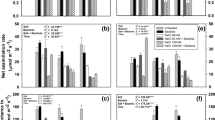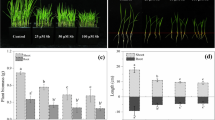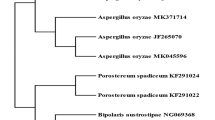Abstract
Chromium (Cr) causes toxic effects in plants by generating reactive oxygen species (ROS) which create oxidative environment. Azotobacter vinelandii helps in growth and development of many crops; however, its role in Cr stress tolerance in rice has not been explored. Here, we report the new function of Azotobacter vinelandii strain SRI Az3 (Accession number JQ796077) in providing Cr stress tolerance in Oryza sativa (var. IR64). The efficiency of the strain was checked under different concentrations (50, 100, 150, 200 and 250 µM) of Cr stress and it was observed that it provides stress tolerance to rice plant up to 200 µM concentration. Different agronomic growth parameters were found to be better in this strain of Azotobacter vinelandii-inoculated rice plants as compared to un-inoculated one. The agronomic growth and photosynthetic characteristics such as net photosynthetic rate (PN), stomatal conductance (gs), intercellular CO2 (Ci) were also found to be significantly increased with increasing concentration of Azotobacter vinelandii inoculation. The activities of antioxidant enzymes were significantly higher (35%) in rice plants inoculated with Azotobacter vinelandii as compared with un-inoculated rice plant. All these positive effects of Azotobacter vinelandii help rice to survive from the toxic effect of Cr.




Similar content being viewed by others
References
Aebi H (1984) Catalase in vitro. Methods Enzymol 105:121–126. https://doi.org/10.1016/s0076-6879(84)05016-3
Ahmad M, Wahid A, Ahmad SS, Butt ZA, Tariq M (2011) Ecophysiological responses of rice (Oryza sativa l.) To hexavalent chromium. Pak J Bot 43:2853–2859
Arnon DI (1949) Copper enzymes in isolated chloroplasts in polyphenoloxidase in beta vulgaris. Plant Physiol 24:1–15
Arun KS, Cervantes C, Herminia L-T, Avudainayagamd S (2005) Chromium toxicity in plants. Environ Int 31:739–753
Bakshi A, Panigrahi AK (2018) A comprehensive review on chromium induced alterations in fresh water fishes. Toxicol Rep 5:440–447
Bates LS, Waldren RP, Teare ID (1973) Rapid determination of proline in water stress studies. Plant Soil 39:205–207
Becquer T, Quantin C, Sicot M, Boudot JP (2003) Chromium availability in ultramafic soils from New Caledonia. Sci Total Environ 301:251–261
Bentsink L, Alonso-Blanco C, Vreugdenhil D, Tesnier K, Groot SPC, Koornneef M (2000) Genetic analysis of seed soluble oligosaccharides in relation to seed storability of Arabidopsis. Plant Physiol 124:1595–1604
Bhardwaj D, Ansari MW, Sahoo RK, Tuteja N (2014) Biofertilizers function as key player in sustainable agriculture by improving soil fertility, plant tolerance and crop productivity. Microb Cell Fact 13:66
Bradford MM (1976) A rapid sensitive method for the quantification of microgram quantities of protein utilising the principle of protein-Dye Binding. Anal Biochem 72:248–254
Bohnert HJ, Jensen RG (1996) Strategies for engineering water stress tolerance in plants. Trends Plant Sci 14:89–97
Camargo FA, Okeke BC, Bento FM, Frankenberger WT (2003) In vitro reduction of hexavalent chromium by a cell-free extract of Bacillus sp. ES 29 stimulated by Cu2+. Appl Microbiol Biot 62:569–573
Castro RO, Trujillo MM, Bucio JL, Cervantes C, Dubrovsky J (2007) Effects of dichromate ongrowth and root system architecture of Arabidopsis thaliana seedlings. Plant Sci 172:684–691
Chapman HD, Pratt PF (1982) Method and of analysis of soil, plant and water, 2nd edn. California University Agricultural Division, p 170
Chatterjee S, Sau GB, Mukherjee SK (2009) Plant growth promotion by a hexavalent chromium reducing bacterial strain, Cellulosimicrobium cellulans KUCr3. World J Microbiol Biotechnol 25:1829–1836. https://doi.org/10.1007/s11274-009-0084-5
Chen GX, Asada K (1999) Ascorbate peroxidase in tea leaves: occurrence of two isozymes and the differences in their enzymatic and molecular properties. Plant Cell Physiol 30:987–998
Chen Y, Li F, Ma Y, Chong K, Xu Y (2013) Overexpression of OrbHLH001, a putative helix-loop-helix transcription factor, causes increased expression of AKT1 and maintains ionic balance under salt stress in rice. J Plant Physiol 170:93–100
Choudhary SP, Kanwar M, Bhardwaj R, Yu JQ, Tran LSP (2012) Chromium stress mitigation by polyaminebrassinosteroid application involves phytohormonal and physiological strategies in Raphanus sativus L. PLoS ONE 7:e33210
Chowdhury AR, Datta R, Sarkar D (2018) Heavy metal pollution and remediation. Green Chem 3:359–373
Das AJ, Kumar M, Kumar R (2013) Plant growth promoting rhizobacteria (pgpr): an alternative of chemical fertilizer for sustainable, environment friendly agriculture. Res J Agric Fores Sci 1:21–23
Dhali S, Pradhan M, Sahoo RK, Pradhan C, Mohanty S (2020) Growth and biochemical variations in Macrotyloma uniflorum var. madhu under chromium stress. Indian J Agric Sci 54:95–100
Dixit V, Pandey V, Shyam R (2002) Chromium ions inactivate electron transport and enhance superoxide generation in vivo in pea (Pisum sativum L. cv. Azad) root mitochondria. Plant Cell Environ 25:687–693
Dube BK, Tewari K, Chatterjee J, Chatterjee C (2003) Excess chromium alters uptake and translocation of certain nutrients in Citrullus. Chemosphere 53:1147–1153
Faisal M, Hasnain S (2005) Bacterial Cr (VI) reduction concurrently improves sunflower (Helianthus Annuus L.) growth. Biotechnol Lett 27:943–947. https://doi.org/10.1007/s10529-005-7188-2
Fan L, Ma Z, Liang J, Li H, Wang E, Wei G (2011) Characterization of a copper-resistant symbiotic bacterium isolated from Medicago lupulina growing in mine tailings. Bioresour Technol 102:703–709
Foucault Y, Leveque T, Xiong T, Schreck E, Austruy A, Shahid M, Dumat C (2013) Green manure plants for remediation of soils polluted by metals and metalloids: ecotoxicity and human bioavailability assessment. Chemosphere 93:1430–1435
Garg B, Jaiswal JP, Misra S, Tripathi BN, Prasad MA (2012) A comprehensive study on dehydration-induced antioxidative responses during germination of Indian bread wheat (Triticum aestivum L. em Thell) cultivars collected from different agroclimatic zones. Physiol Mol Biol Plants 18:217–228
Gupta PK (2004) Methods in environmental analysis water, soil and air. Agrobios, India, pp 242–245
He MY, Li XY, Liu HL, Miller SJ, Wang GJ, Rensing C (2011) Characterization and genomic analysis of a chromate resistant and reducing bacterial strain Lysinibacillus fusiformis ZC1. J Hazard Mater 185:682–688
Heu Y, Ge Y, Zang C, Zu T, Cheng W (2009) Cd toxicity and translocation in rice seedlings are reduced by hydrogen peroxide treatments. Plant Growth Regul 5(1):51–61. https://doi.org/10.1007/s10725-009-9387-7
Jackson TL (1973) Soil chemical analysis. Prentice-Hall of India Private Limited, New Delhi, p 498
Jun R, Ling T, Guanghua Z (2009) Effects of chromium on seed germination, root elongation and coleoptiles growth in six pulses. Inter J Environ Sci Technol 6:571–578
Karkacier M, Erbas M, Uslu MK, Aksu M (2003) Comparison of different extraction and detection methods for sugars using amino-bonded phase HPLC. J Chromatogr Sci 41:331–333
Karuppiah PS, Rajaram J (2011) Exploring the potential of chromium reducing Bacillus sp. and there plant growth promoting activities. Microbiol Res 1:17–23
Kavi-Kishor PB, Sreenivasulu N (2014) Is proline accumulation per se correlated with stress tolerance or is proline homeostasis a more critical issue? Plant Cell Environ 37:300–311. https://doi.org/10.1111/pce.12157
Khatun MR, Mukta RH, Islam MA, Huda AKMN (2019) Insight into citric acid-induced chromium detoxification in rice (Oryza sativa. L). Int J Phytoremediation 31:1–7
Liang X, Zhang L, Natarajan SK, Becker DF (2013) Proline mechanisms of stress survival. Antioxid Redox Sig 19:998–1011
Maqbool Z, Asghar HN, Shahzad T, Hussain S, Riaz M, Ali S, Arif MS, Maqsood M (2015) Isolating, screening and applying chromium reducing bacteria to promote growth and yield of okra (Hibiscus esculentus L) in chromium contaminated soils. Ecotoxicol Environ Saf 114:343–349. https://doi.org/10.1016/j.ecoenv.2014.07.007
Medda S, Mondal NK (2017) Chromium toxicity and ultrastructural deformation of Cicer arietinum with special reference of root elongation and coleoptile growth. Ann Agrar Sci 15:396–401
Morel MA, Ubalde MC, Braña V et al (2011) Delftia sp. JD2: a potential Cr (VI)-reducing agent with plant growth-promoting activity. Arch Microbiol 193:63–68. https://doi.org/10.1007/s00203-010-0632-2
Nagarajan M, Ganesh SK (2015) Toxic effects of chromium on growth of some paddy varieties. Intl Lett Nat Sci 35:36–44
Panda SK, Choudhury S (2005) Chromium stress in plants. Braz J Plant Physiol 17:95–102
Peleg Z, Reguera M, Tumimbang E, Walia H, Blumwald E (2011) Cytokinin-mediated source/sink modifications improve drought tolerance and increase grain yield in rice under water-stress. Plant Biotechnol J 9:747–758
Rai PK, Lee SS, Zhang M, Tsang YF, Kim KH (2019) Heavy metals in food crops: health risks, fate, mechanisms, and management. Environ Int 125:365–385
Rajkumar M, Nagendran R, Lee KJ, Lee WH (2005) Characterization of a novel Cr 6+ reducing Pseudomonas sp. with plant growth-promoting potential. Curr Microbiol 50:266–271
Romanenko VI, Koren’kov VN (1977) A pure culture of bacteria utilizing chromates and bichromates as hydrogen acceptors in growth under anaerobic conditions. Mikrobiologiya 46:414–417
Roy P, Niyogi K, SenGupta DN, Ghosh B (2005) Spermidine treatment to rice seedlings recovers salinity stressinduced damage of plasma membrane and PM-bound H+-ATPase in salt-tolerant and saltsensitive rice cultivars. Plant Sci 168:583–591
Sabir M, Waraich EA, Hakeem KR, Ozturk M, Ahmad HR, Shahid M (2015) Phytoremediation: mechanisms and adaptations. Soil Remediat Plants 4:85–105
Sahoo RK, Ansari MW, Dangar TK, Mohanty S, Tuteja N (2014) Phenotypic and molecular characterization of efficient nitrogen-fixing Azotobacter strains from rice fields for crop improvement. Protoplasma 251:511–523
Saifullah SM, Zia-Ur-Rehman M, Sabir M, Ahmad HR (2015) Phytoremediation of Pb contaminated soils using synthetic chelates. In: Hakeem K, Sabir M, Ozturk M, Murmet A (eds) Soil remediation and plants. Elsevier, San Diego, pp 397–414
Salt DE, Smith RD, Raskin I (1998) Phytoremediation. Annu Rev Plant Physiol Plant Mol Biol 49:643–668
Sambrook J, Russell DW (2001) Molecular cloning: a laboratory manual. Cold Spring Harb Lab Press 3:114–115
Shahid M, Shamshad S, Rafiq M, Khalid S, Bibi I, Niazi NK, Dumat C, Rashid MI (2017) Chromium speciation, bioavailability, uptake, toxicity and detoxification in soil-plant system: a review. Chemosphere 178:513–533. https://doi.org/10.1016/j.chemosphere.2017.03.074
Shanker AK, Cervantes C, Loza-Tavera H, Avudainayagam S (2005) Chromium toxicity in plants. Environ Int 31:739–753
Sharma I, Pati PK, Bhardwaj R (2011) Effect of 28- homobrassinolide on antioxidant defence system in Raphanus sativus L. under chromium toxicity. Ecotoxicology 20:862–874
Sharma A, Kapoor D, Wang J, Shahzad B, Kumar V, Bali AS, Jasrotia S, Zheng B, Yuan H, Yan D (2020) Chromium bioaccumulation and its impacts on plants: an overview. Plants 9:100
Smith IK, Vierheller TL, Thorne CA (1988) Assay of glutathione reductase in crude tissue homogenates using 5, 5 -dithiobis (2- nitrobenzoic acid). Ann Biochem 175:408–413
Solanki R, Dhankhar R (2011) Biochemical changes and adaptive strategies of plants under heavy metal stress. Biologia 66:195–204
Soliman W, Fujimori M, Tase K, Sugiyama S (2011) Oxidative stress and physiological damage under prolonged heat stress in C3 grass Lolium perenne. Grassland Sci 57:101–106
Soni SK, Singh R, Singh M, Awasthi A, Wasnik K, Kalra A (2014) Pretreatment of Cr (VI)-amended soil with chromate-reducing rhizobacteria decreases plant toxicity and increases the yield of Pisum sativum. Arch Environ Contam Toxicol 66:616–627
Sundaramoorthy P, Chidambaram A, Ganesh KS, Unnikannan P, Baskaran L (2010) Chromium stress in paddy: (i) nutrient status of paddy under chromium stress; (ii) phytoremediation of chromium by aquatic and terrestrial weeds. C R Biol 333:597–607
Trivedi P, Pandey A, Sa T (2007) Chromate reducing and plant growth promoting activities of psychrotrophic Rhodococcus erythropolis MtCC 7,905. J Basic Microbiol 47(6):513–517. https://doi.org/10.1002/jobm.200700224
Tuteja N, Sahoo RK, Garg B, Tuteja R (2013) OsSUV3 dual helicase functions in salinity stress tolerance by maintaining photosynthesis and antioxidant machinery in rice (Oryza sativa L. cv. IR64). Plant J 76:115–127. https://doi.org/10.1111/tpj.12277
Tuteja N, Banu MSA, Huda KMK, Gill SS, Jain P, Pham XH, Tuteja R (2014) Pea p68, a DEAD-box helicase, provides salinity stress tolerance in transgenic tobacco by reducing oxidative stress and improving photosynthesis machinery. PLoS ONE 9(5):e98287. https://doi.org/10.1371/journal.pone.0098287
Vernay P, Gauthier-Moussard C, Hitmi A (2007) Interaction of bioaccumulation of heavy metal chromium with water relation, mineral nutrition and photosynthesis in developed leaves of Lolium perenne L. Chemosphere 68:1563–1575
Vernay P, Gauthier-Moussard C, Jean L, Bordas F, Faure O, Ledoigt G, Hitmi A (2008) Effect of chromium species on phytochemical and physiological parameters in Datura innoxia. Chemosphere 72:763–771
Wakeel A, Xu M, Gan Y (2020) Chromium-induced reactive oxygen species accumulation by altering the enzymatic antioxidant system and associated cytotoxic, genotoxic, ultrastructural, and photosynthetic changes in plants. Int J Mol Sci 21:728
Wani PA, Khan MS, Zaidi A (2008) Chromium-reducing and plant growth-promoting Mesorhizobium improves chickpea growth in chromium-amended soil. Biotechnol Lett 30:159–163. https://doi.org/10.1007/s10529-007-9515-2
Wani SA, Chand S, Ali T (2013) Potential use of Azotobacter chroococcum in crop production: an overview. Curr Agric Res J 1:35–38
Yadav SK, Dhote M, Kumar P, Sharma J, Chakrabarti T, Juwarkar AA (2010) Differential antioxidative enzyme responses of Jatropha curcas L. to chromium stress. J Hazard Mater 180:609–615
Yu XZ, Gu JD (2007) Accumulation and distribution of trivalent chromium and effects on hybrid willow (Salix matsudana Koidz x alba L.) metabolism. Arch Environ Contam Toxicol. 52(4):503–511
Yu XZ, Lin YJ, Zhang Q (2019) Metallothioneins enhance chromium detoxification through scavenging ROS and stimulating metal chelation in Oryza sativa. Chemosphere 220:300–313
Zaheer IE, Ali S, Saleem MH, Arslan Ashraf M, Ali Q, Abbas Z, Rizwan M, El-Sheikh MA, Alyemeni MN, Wijaya L (2020) Zinc-lysine supplementation mitigates oxidative stress in rapeseed (Brassica napus l.) by preventing phytotoxicity of chromium, when irrigated with tannery wastewater. Plants 9(9):E1145. https://doi.org/10.3390/plants9091145
Zhang Q, Lin L, Zhu X, Liu Q, Yang Y, Yuan W, Shao J (2010) Eco-physiological responses of rice (Oryza sativa L.) roots to zinc, chromium stress. In: 4th International Conference on bioinformatics and biomedical engineering, Chengdu, China.
Acknowledgements
We are thankful to Dr. Madhusmita Pradhan for help in preparation of the manuscript.
Author information
Authors and Affiliations
Contributions
RKS performed all the experiments and wrote the first draft of the manuscript. VR helped RKS during performing experiments. NT supervised all the experiments and wrote the final manuscript. All the authors have read and approved the manuscript.
Corresponding author
Ethics declarations
Conflict of interest
The authors have nothing to disclose.
Rights and permissions
About this article
Cite this article
Sahoo, R.K., Rani, V. & Tuteja, N. Azotobacter vinelandii helps to combat chromium stress in rice by maintaining antioxidant machinery. 3 Biotech 11, 275 (2021). https://doi.org/10.1007/s13205-021-02835-3
Received:
Accepted:
Published:
DOI: https://doi.org/10.1007/s13205-021-02835-3




